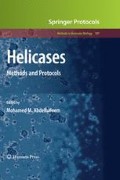Abstract
Helicases are essential for DNA metabolism. Different helicases have different properties tailored to fulfill their specific tasks. RecQ-helicases are known to be important in DNA repair and DNA recombination. In higher organisms several RecQ homologues can be identified. For instance, seven RecQ homologues were identified in the model plant Arabidopsis thaliana. Specialization of those proteins can possibly be reflected by differences in their biochemical substrate spectrum. Moreover, a helicase of interest might be defined by its biochemical properties as a functional ortholog of a RecQ helicase in other organisms. In this chapter the initial steps that will provide the basis for a proper biochemical characterization are given. After the description of the expression of the helicase of interest in the heterologous host Escherichia coli, its purification with the help of two affinity tags and the preparation of a model DNA substrate for the strand displacement assay are described. Finally, it is shown how this model substrate can be used to ensure the purity of the enzymatic preparation of interest.
Access this chapter
Tax calculation will be finalised at checkout
Purchases are for personal use only
References
Sharma S., Doherty K. M., and Brosh R. M., Jr. (2006) Mechanisms of RecQ helicases in pathways of DNA metabolism and maintenance of genomic stability. Biochem. J. 398, 319–337.
Bachrati C. Z. and Hickson I. D. (2003) RecQ helicases: suppressors of tumorigenesis and premature aging. Biochem. J. 374, 577–606.
Hanada K. and Hickson I. D. (2007) Molecular genetics of RecQ helicase disorders. Cell Mol. Life. Sci. 64, 2306–2322.
Hickson I. D. (2003) RecQ helicases: caretakers of the genome. Nat. Rev. Cancer 3, 169–178.
Opresko P. L., Cheng W. H., and Bohr V. A. (2004) Junction of RecQ helicase biochemistry and human disease. J. Biol. Chem. 279, 18099–18102.
Hartung F., Plchova H., and Puchta H. (2000) Molecular characterisation of RecQ homologues in Arabidopsis thaliana. Nucleic Acids Res. 28, 4275–4282.
Hartung F., Suer S., and Puchta H. (2007) Two closely related RecQ helicases have antagonistic roles in homologous recombination and DNA repair in Arabidopsis thaliana. Proc. Natl. Acad. Sci. U.S.A. 104, 18836–18841.
Popuri V., Bachrati C. Z., Muzzolini L., et al. (2008) The Human RecQ helicases, BLM and RECQ1, display distinct DNA substrate specificities. J. Biol. Chem. 283, 17766–17776.
Kobbe D., Blanck S., Demand K., Focke M., and Puchta H. (2008) AtRECQ2, a RecQ-helicase homologue from Arabidopsis thaliana, is able to disrupt different recombinogenic DNA-structures in vitro. Plant J. 55, 397–405.
Tuteja N. and Tuteja R. (2004) Unraveling DNA helicases. Motif, structure, mechanism and function. Eur. J. Biochem. 271, 1849–1863.
Brosh R. M., Jr., Orren D. K., Nehlin J. O., et al. (1999) Functional and physical interaction between WRN helicase and human replication protein A. J. Biol. Chem. 274, 18341–18350.
Studier F. W. and Moffatt B. A. (1986) Use of bacteriophage T7 RNA polymerase to direct selective high-level expression of cloned genes. J. Mol. Biol. 189, 113–130.
Stofko-Hahn R. E., Carr D. W., and Scott J. D. (1992) A single step purification for recombinant proteins. Characterization of a microtubule associated protein (MAP 2) fragment which associates with the type II cAMP-dependent protein kinase. FEBS Lett. 302, 274–278.
Chaga G. S. (2001) Twenty-five years of immobilized metal ion affinity chromatography: past, present and future. J. Biochem. Biophys. Methods 49, 313–334.
Brosh R. M., Jr., Opresko P. L., and Bohr V. A. (2006) Enzymatic mechanism of the WRN helicase/nuclease. Methods Enzymol. 409, 52–85.
Bachrati C. Z. and Hickson I. D. (2006) Analysis of the DNA unwinding activity of RecQ family helicases. Methods Enzymol. 409, 86–100.
Sambrook J. and Russell D. W. (2001) Molecular Cloning: A Laboratory Manual. 2nd ed. Cold Spring Harbor, NY: Cold Spring Harbor Laboratory.
Terpe K. (2006) Overview of bacterial expression systems for heterologous protein production: from molecular and biochemical fundamentals to commercial systems. Appl. Microbiol. Biotechnol. 72, 211–222.
Grossman T. H., Kawasaki E. S., Punreddy S. R., and Osburne M. S. (1998) Spontaneous cAMP-dependent derepression of gene expression in stationary phase plays a role in recombinant expression instability. Gene 209, 95–103.
Acknowledgments
We thank Katharina Demand and Sandra Blanck for active involvement in the processes described. Furthermore, we thank Helena Plchova, Jasmin Duerr, Verena Geuting, and Sandra Thies for sharing their experiences on the different methods and Sabrina Hettinger and Carina Moock for skillful technical assistance. This work has been supported by the DFG with grant number Pu 137/8.
Author information
Authors and Affiliations
Editor information
Editors and Affiliations
Rights and permissions
Copyright information
© 2009 Humana Press, a part of Springer Science+Business Media, LLC
About this protocol
Cite this protocol
Kobbe, D., Focke, M., Puchta, H. (2009). Purification and Characterization of RecQ Helicases of Plants. In: Abdelhaleem, M. (eds) Helicases. Methods in Molecular Biology, vol 587. Humana Press, Totowa, NJ. https://doi.org/10.1007/978-1-60327-355-8_14
Download citation
DOI: https://doi.org/10.1007/978-1-60327-355-8_14
Published:
Publisher Name: Humana Press, Totowa, NJ
Print ISBN: 978-1-60327-354-1
Online ISBN: 978-1-60327-355-8
eBook Packages: Springer Protocols

